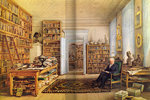| Meeting 19 • 13 March 2012 • Tuesday |
Version: |
|
pictures of the week |
thought-bite of the week: |
|
|
"Gold dug out from the ground has, in the people's eyes, a special lure unrelated to the diligent farmer harvesting a fertile land under a gentle climate." |
|
mini-text of the week: "'…What an odd experience it was to find ourselves in these vast solitudes with a man who believed he was European, with all the vain pretensions, hereditary prejudices and mistakes of civilization, but whose only roof was a tree.'" Humboldt, "Personal Narrative", from Jaguars and Electric Eels, ed. & trans. Wilson, pp. 71 (read more) |
|
(X') = anticipated time in minutes (total=75) |
(0001) etc.=item in Humboldt Project document collection |
|
Key to notes added AFTER the class meets: |
|
|
√ = topic / activity that was adequately dealt with during the class |
+ = topic that was started but needs more attention & will be resumed at next / subsequent meeting(s) |
|
- = a topic / activity that was proposed though not begun, but will be taken up later |
|
|
Italic bold green text like this = comments after the meeting |
|
|
√ |
(5') Thought-bite of the week: How far are we from being "farmer[s] harvesting a fertile land"? How close to "gold dug from the ground"? |
|
√ |
(10') A (second-to-)last look at data-gathering: instruments then and now 5) A WWII-era sextant: its developer and basic principles; Main point: instruments Then had many parts and observations were tedious but still more accurate than our everyday measurements Now (degree of latitude mid-19th-C: withing 1/2 mile); instruments now are electronic and gather far more data with far greater accuracy - and we don't have to do much math. Turning point for the sextant: sometime after 1945; AvH would have understood the 1945 sextant - it was mechanically much like the sextants of his time; but the iPhone "Sextant" app would puzzle him (for a while), because it's not mechanical. He would, however, understand the workings of GPS. Math challenge: how accurate is the "Theodolite" app? But first: How long is 1/10,000 of a degree of latitude? in feet? in meters? |
|
√ |
(10') Group projects: How close to ready? Where's the Humboldt tie-in? How to package and present as your course assignment? How scored and graded? Contest asks schoolkids to answer, "What is a flame?" If time: Value of hands-on learning - a demonstration for math: Why, indeed, is the area of a circle calculated by squaring its radius and multiplying that by pi? |
|
+ |
(20') Contact of cultures, class of civilizations: The definition of "human" then and now - according to law, philosophy, science, culture, emotion, _____? The "Noble Savage" and the salvaje-orangutan of Jaguars & Eels p. 84. Picturing the Tropics (see Stepan, Nancy Lee, Picturing Tropical Nature, Ithaca: Cornell UP, 2001). |
|
+ |
(15') John Wesley Powell, "beyond the 100th meridian", settlement of the American West, Oregon, and water/land use. Policies of resource allocation, agriculture, mining: Jefferson, Powell, corporate/federal. The three E's of sustainability. What does "interconnectedness" mean to you now? See Stegner, Wallace, Beyond the Hundredth Meridian, 1953; rpt. Penguin, 1992, and Worster, Donald, A River Running West: The Life of John Wesley Powell, Oxford UP, 2001. Basic biographical sources: Wikipedia; PBS "American Experience" (Powell & Bureau of Ethnology); Powell Museum at Lake Powell ("Explore with Us") |
|
√ |
(10') Reading selection ("Climbing the Redwoods") as practice for part of final exam; discussion topics: 1) Does the author deliver the science? |
|
√ |
(5') Checkups & Previews: Scoring guide for Species Description is now ready. Next meeting: More about land and water use; more about what the "educated citizen" might read; maybe Powell and other American ethnographers; Humboldt's Cosmos; critiquing Humboldt (French Revolution?); how to review for the final exam (REVIEW THE COURSE MEETING PAGES linked from the SCHEDULE page); how to finish up course work. Job / internship / volunteer opportunities: Sauvie Island Center , spring (with credit if arranged) Youth Leaders for Sustainability (various skills needed) |

